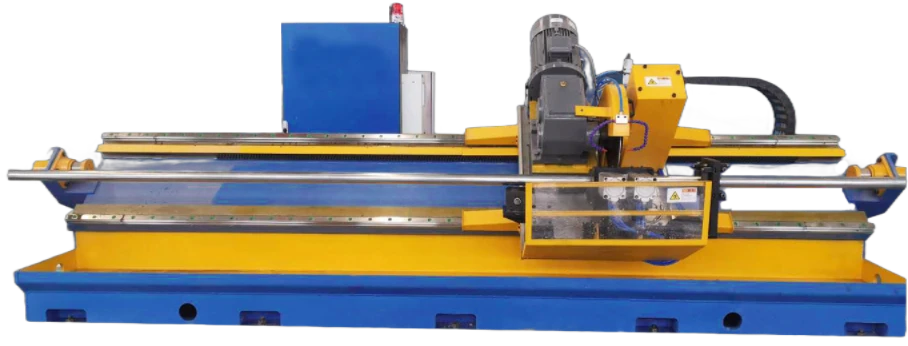Components and Functions of an Uncoiler Machine in Industrial Applications
Uncoiler Machine Parts An Overview of Essential Components and Their Functions
Uncoiler machines play a pivotal role in various manufacturing processes, particularly in the metalworking and fabrication industries. These machines are designed to unwind coils of metal or other materials, facilitating continuous production runs without interruptions. Understanding the essential parts of an uncoiler machine can significantly enhance efficiency and maintenance practices. In this article, we will explore the crucial components of an uncoiler machine and their respective functions.
1. Base Frame
The base frame is the foundational structure of an uncoiler machine. Typically constructed from sturdy steel, the base frame provides stability and support for the entire machine. It is designed to withstand the weight of heavy coils and the dynamic forces encountered during operation. A robust base frame ensures that the uncoiler maintains its position and functionality, reducing vibrations that might affect the quality of the uncoiled material.
2. Coil Mandrel
The coil mandrel is perhaps the most critical component of the uncoiler machine. It is the cylindrical core onto which the coil is mounted. The mandrel can be pneumatic or mechanical and is designed to securely hold various coil sizes and weights. Its primary function is to facilitate smooth unwinding of the material, and its diameter can be adjusted to accommodate different coil dimensions. A well-designed mandrel ensures that the coil is centered and aligned, which is crucial for preventing material defects during the uncoiling process.
The driving mechanism regulates the unwinding process of the coil. This could be a motorized system that controls the speed at which the coil unwinds, ensuring a consistent feed rate. Many uncoilers utilize a retractable reel or a variable-speed drive system to increase or decrease the unwinding speed based on production needs. Proper calibration of the driving mechanism is crucial, as it helps maintain tension in the material, preventing slippage or deformation.
4. Tension Control System
uncoiler machine parts

The tension control system plays a vital role in managing the force applied to the coil as it unwinds. This system can include pneumatic or hydraulic cylinders that automatically adjust the tension based on the material's characteristics and the process requirements. Maintaining optimal tension is essential, as it not only ensures smooth unwinding but also protects the integrity of the material, preventing kinks or distortion.
5. Guide Rollers
Guide rollers are strategically placed along the uncoiler machine to direct the pathway of the unwound material. These rollers help prevent deviations in the material's trajectory, ensuring a straight and uniform flow. They are particularly important in high-speed operations, where even the slightest misalignment could lead to significant disruptions. Properly aligned guide rollers enhance overall production efficiency and reduce wear on the material being processed.
6. Control Panel
The control panel serves as the operational hub of the uncoiler machine. It houses various controls for adjusting speed, tension, and overall machine settings. Modern uncoiler machines often incorporate advanced digital controls that allow operators to monitor performance metrics in real-time. These features improve user-friendliness and enable quick adjustments, ensuring the machine operates within optimal parameters.
7. Safety Features
Safety components are crucial in any machinery, and uncoiler machines are no exception. Features such as emergency stop buttons, safety guards, and sensors are installed to protect operators and prevent accidents. Safety standards in manufacturing have steadily increased, making it essential for uncoilers to comply with industry regulations. Ensuring that safety features are functional and regularly maintained is critical for the well-being of operators.
Conclusion
Uncoiler machines are indispensable in many industrial applications, and understanding their parts is essential for optimizing performance and ensuring longevity. By familiarizing oneself with components such as the base frame, coil mandrel, driving mechanism, tension control system, guide rollers, control panel, and safety features, operators and maintenance personnel can improve operational efficiency and uphold safety standards. As technology continues to evolve, innovations in uncoiler machine design will likely enhance their functionality and ease of use, further solidifying their role in modern manufacturing.
-
High Frequency Straight Seam Welded Pipe Production Line-BzZhou Xinghua Machinery Equipment Manufacturing Co., LTD.|line pipe steel&welded gas pipeNewsJul.30,2025
-
High Frequency Straight Seam Welded Pipe Production Line-BzZhou Xinghua Machinery Equipment Manufacturing Co., LTD.|High Precision&Automated SolutionsNewsJul.30,2025
-
High Frequency Straight Seam Welded Pipe Production Line - BzZhou Xinghua Machinery Equipment Manufacturing Co., Ltd.NewsJul.30,2025
-
High Frequency Straight Seam Welded Pipe Production Line-BzZhou Xinghua Machinery Equipment Manufacturing Co., LTD.|Precision Welding, High EfficiencyNewsJul.30,2025
-
High Frequency Straight Seam Welded Pipe Production Line|BzZhou Xinghua|Precision Welding&EfficiencyNewsJul.30,2025
-
High Frequency Straight Seam Welded Pipe Production Line - BzZhou Xinghua|Precision Engineering&EfficiencyNewsJul.30,2025


